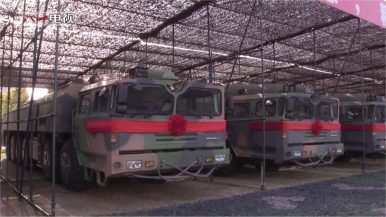By Ankit Panda
 In late April 2018, China formally commissioned a brigade of Dong Feng 26 (DF-26) intermediate-range ballistic missiles (IRBM). As I discussed then, the first brigade consists of what appear to be 22 transporter-erector-launchers. The missiles are capable of both conventional and nuclear payloads; in their conventional configuration, they become the world’s longest-range conventional payload-bearing ballistic missile, with a maximum range estimated at around 4,000 kilometers. The DF-26 has been informally dubbed China’s “Guam-killer.” Its range gives it the ability to conventionally disable U.S. facilities on Guam, including Andersen Air Force Base, which hosts U.S. Pacific Command’s forward-based bomber presence in the Asia-Pacific. China’s declared nuclear no first-use posture means that, in a conflict, the People’s Liberation Army-Rocket Force would presumably strike these targets with conventionally armed weapons.
In late April 2018, China formally commissioned a brigade of Dong Feng 26 (DF-26) intermediate-range ballistic missiles (IRBM). As I discussed then, the first brigade consists of what appear to be 22 transporter-erector-launchers. The missiles are capable of both conventional and nuclear payloads; in their conventional configuration, they become the world’s longest-range conventional payload-bearing ballistic missile, with a maximum range estimated at around 4,000 kilometers. The DF-26 has been informally dubbed China’s “Guam-killer.” Its range gives it the ability to conventionally disable U.S. facilities on Guam, including Andersen Air Force Base, which hosts U.S. Pacific Command’s forward-based bomber presence in the Asia-Pacific. China’s declared nuclear no first-use posture means that, in a conflict, the People’s Liberation Army-Rocket Force would presumably strike these targets with conventionally armed weapons.
But is the DF-26 primarily a weapon for U.S. targets and only U.S. targets?
Over at the Interpreter, Peter Layton gives thought to what the conventionally armed DF-26 implies for Australian security. Layton notes that the DF-26, like the DF-21C/D that preceded it, are of concern to Australia. He correctly observes that, taking the DF-26’s capabilities at face value, the PLARF could easily range “northern Australia, including Darwin, Katherine (Tindal), and Derby (Curtin).”
Layton recommends a range of measures to improve the survivability of Australian forces against Chinese strikes in the event of a conflict. (Australia, as a U.S. ally, could be expected to join Washington as a belligerent, leaving its military open to Chinese strikes.) There are two realistic means of improving the survivability of Australian forces.
The first is to invest in area and point missile defense systems to lower the probability that a Chinese DF-26 is able to successfully penetrate Australian territory to degrade Canberra’s power-projection capabilities. Layton mentions ship-based SM-3 Block IIA interceptors and land-based THAAD batteries as two possible options for Australia. Setting aside cost, its unclear either would be a particularly smart survivability play.
The SM-3 Block IIA, though no doubt a capable mid-course system on paper, has a disappointing interception test record, with two recent failures. Moreover, given the possible trajectories of DF-26 missiles from China toward Australia, Canberra would likely be forced to either engage incoming missiles in late-midcourse or even descent, reducing the chances of a successful interception. THAAD, while providing a smaller area of coverage than ship-based SM-3 IIAs, has just seen one test against an IRBM-class target.
It’s apparent why Canberra needs to take the DF-26 and other Chinese ballistic missile systems as a serious challenge, but ultimately the PLARF is likely to concern itself with denying theater power projection to the United States. Washington already has several Aegis-equipped destroyers in the Asia-Pacific and Guam hosts a THAAD site. While SM-3 Block IIA deployment timetables have been delayed by one year, the PLARF will not feel convinced of a sufficiently developed soft counterforce capability against the United States with even two deployed DF-26 brigades.
For Australia and other regional U.S. allies and partner states concerned about Chinese long-range precision conventional strike capabilities and force survivability, the smarter and more cost-effective play in the long-term would be to horizontally build out those capabilities that’d make a difference in a conflict with China. For Australia, this might include the pursuit of additional frigates and even attack submarines.
No comments:
Post a Comment